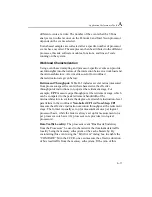
Using Performance Monitoring Events
B
B-3
Replay
In order to maximize performance for the common case, the Intel
NetBurst microarchitecture sometimes aggressively schedules
μ
ops for
execution before all the conditions for correct execution are guaranteed
to be satisfied. In the event that all of these conditions are not satisfied,
μ
ops must be reissued. This mechanism is called replay.
Some occurrences of replays are caused by cache misses, dependence
violations (for example, store forwarding problems), and unforeseen
resource constraints. In normal operation, some number of replays are
common and unavoidable. An excessive number of replays indicate that
there is a performance problem.
Assist
When the hardware needs the assistance of microcode to deal with some
event, the machine takes an
assist
. One example of such situation is an
underflow condition in the input operands of a floating-point operation.
The hardware must internally modify the format of the operands in
order to perform the computation. Assists clear the entire machine of
μ
ops before they begin to accumulate, and are costly. The assist
mechanism on the Pentium 4 processor is similar in principle to that on
the Pentium II processors, which also have an assist event.
Tagging
Tagging is a means of marking
μ
ops to be counted at retirement. See
Appendix A of the
IA-32 Intel® Architecture Software Developer’s
for the description of the tagging mechanisms. The
same event can happen more than once per
μ
op. The tagging
mechanisms allow a
μ
op to be tagged once during its lifetime. The
retired suffix is used for metrics that increment a count once per
μ
op,
rather than once per event. For example, a
μ
op may encounter a cache
Summary of Contents for ARCHITECTURE IA-32
Page 1: ...IA 32 Intel Architecture Optimization Reference Manual Order Number 248966 013US April 2006...
Page 220: ...IA 32 Intel Architecture Optimization 3 40...
Page 434: ...IA 32 Intel Architecture Optimization 9 20...
Page 514: ...IA 32 Intel Architecture Optimization B 60...
Page 536: ...IA 32 Intel Architecture Optimization C 22...






























